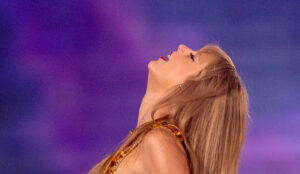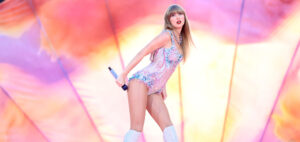I’m just off the train at Nanterre, a suburb west of Paris, and walking down a pedestrianised avenue to Paris La Defense Arena, a hulking, 40,000-capacity quadrilateral that’s the largest indoor arena in Europe. “Welcome to New York”, sings one of the most recognisable voices of the 21st century from the speakers lining the road. The dissonance is fitting. If Taylor Swift can rearrange politics, geopolitics and economics, why not geography?
The Paris La Defense Arena is where, last night, Swift began the European leg of her Eras Tour, which sprouts records and superlatives like Midas makes gold. The 2023 dates made it the first concert tour to ever gross a billion dollars. It’s forecast to double that this year. After sweeping through Asia — where a minor diplomatic incident went down when Singapore offered government subsidies to get regional exclusivity — Swift has now reached the old world. Four shows in Paris and 51 across the continent in total, ending with a five-night run at Wembley Stadium in August. She’s not the only American in town. Both the Eurostar from London and Paris itself ring out with well-projected US accents. Forget the doomy warblings about Washington’s geopolitical ebb: the spring sun is out, the dollar is strong and Europe is America’s playground.
Concertgoers — mostly young, mostly female — are in sparkly dresses, cowboy boots and glitter. The few guys here are dressed down to the point of invisibility; tonight, humanity joins those few species of birds and insects where bright colours are for babes only.
Swift is scheduled to start at eight. Two minutes beforehand, a clock on the giant screen which stretches across the back of the stage counts down — and right on time, we begin. As the arena lights dim, the tens of thousands of swaying smartphone cameras illuminate, like a phosphorescent ocean. Dancers shimmy out trailed by billowing fabric, which they manipulate to form a kind of liquid clam shell. And out of that, like Botticelli’s all-American Venus, emerges Taylor Alison Swift, 34, of West Reading, Pennsylvania, USA.
Taylor Swift inspires love, dedication and obsessive fandom. In me, she has kindled about a decade and a half of mild but increasing curiosity. There are seven Swift songs I recognise from their titles, and none come after 2014. My musical knowledge of her petered out when she was merely a very big star, and in an era where culture was coherent enough for everyone to absorb a certain level of commercial pop. Then I started seeing her in Bloomberg and the Financial Times, attached to stories about inflation and foreign policy.
Taylor Swift’s current era — dating, it seems, from the pandemic onwards — is out-and-out imperial. She was last year’s best-selling artist worldwide, and the year before that too. Her current relationship, with the puppyish American footballer Travis Kelce, is theorised by the more batshit US conservatives to be an elaborate psyop to boost Joe Biden in this year’s presidential election. The European dates of the Eras Tour are the first after the release of her latest album, The Tortured Poets Department, in April. It was not a critical success. “Sylvia Plath did not stick her head in an oven for this!” read a review in Paste magazine — anonymous, because writers who criticise Swift can reliably expect online death threats from fans. Nevertheless, upon release it smashed multiple streaming records.
After the opening number, Swift pauses, for half a minute at least, to take in the sound of the crowd. Blown up to a giantess on screen, Swift looks overwhelmed, as if she hasn’t experienced this reaction before. She has, hundreds of times. But each and every member of the audience must be broken free of the billions of dollars of revenue they represent and made to feel seen. After the pause, Swift extends her wrist, as if offering it up to be kissed, and says: “Enchanté.”
The Eras Tour, as its name suggests, cycles through each of Swift’s “eras”, or albums. The various stage setups reference cityscapes, forests and, at one point, a surreal landscape of steel cages sunk into the ground either side of an open highway. Periodically, Swift sinks down a trapdoor in the middle of the stage, into what must be her era-shifting chamber, then remerges, moments later, from an ingenious new position and in a different outfit. I get the sparkly costumes now, because this is very much what Swift goes in for herself. Sparkly hot pants, sparkly ball gown, sparkly miniskirt with sparkly thigh-high boots — even what looks like a sparkly dressing gown. The battalion of dancers go through endless outfit changes too, but no-one’s allowed to sparkle quite like Swift.
Singing and dancing her way through a typical Eras setlist lasts between three and four hours. Swift began her career writing and performing country songs in Nashville, Tennessee, where music is whittled down to a perfect product. These days, she embraces an opposite but equally American approach: superabundance. Song piles upon song. And every great American genre seems to get a hearing: pop, rock, country, folk, rap, R&B (slow and sultry), R&B (fast and spiky). I almost expect a banger inspired by Washington DC-style hardcore punk.
Not everything works. An hour in, we’ve entered the era of Folklore and Evermore, her pandemic albums. It’s ballad central: wafty and witchy and, to be honest, a bit snoozy. But then we go back in time to 1989 (or 2014, which is when that confusingly named album came out). She launches into “Shake It Off” — one of my precious seven songs — and my subconscious flashes up memories of chugging brilliant blue alcopops in sticky student nightclubs. It’s glorious.
Swift is big in the way that no other modern superstar is. Orders of magnitude bigger. The logarithmic scale could have been invented for her. This bigness manifests in the thousands upon thousands who attend her concerts, and the probable millions that try and fail to get tickets. But out of the many, one — e pluribus, unum, as a teacher might have put it to Swift in an American history class around the turn of the millennium. At one point in the show, Swift compliments the crowd. “I’m making extreme eye contact with everyone; I’m dancing with everyone; you’re so present,” she says. “And it means the world to us as performers.”
Yes, it’s what the pro that she is would and should say. But in the moment, it sounds sincere, or at least well-meaning enough to discourage any attempt to prod at its veracity. For three hours and seven minutes — this ends up being a comparatively brisk performance — Swift assembles her fans, usually only joined up by the spindly limbs of social media, into a physical community. These fans don’t just adore her; they end up adoring each other. Inspired by one of her stray lyrics from 2022, they now make friendship bracelets to trade with strangers at shows.
Truly mass culture in its most tribal form barely exists anymore. The all-consuming influence of the internet has degraded it in two substantial ways. Algorithmically generated feeds on everything from Instagram to Netflix have given us all tastes which are similar but slightly different — amid this torrent of content, it’s harder for youth tribes such as punks or New Romantics to cohere around sets of cultural tenets. And the isolated and antisocial manner in which we consume what these feeds serve up — on our phones, alone — acts as a barrier to shared experience.
But Swift is one of mass culture’s last bastions. And she presents a very good case as to why we should cling on to what’s left of it. She, like few others, can out-muscle the brute force of the algorithm and bring people together to commune around her music — some of which is good, and some of which isn’t, but that’s hardly the point. The point is the ecstatic crowd in front of her.
Her last song is, again, one I don’t know. It’s an up-tempo electropop number with sugar-rush synthesiser lines, and as it plays, we’re dazzled with sparkles, primary colours, fireworks and confetti — all that is good in the world. Swift bows with her band and her dancers, then bows alone. Then she descends, for the final time, into that hole in the stage, to get ready to cast the same spell tomorrow.
Disclaimer
Some of the posts we share are controversial and we do not necessarily agree with them in the whole extend. Sometimes we agree with the content or part of it but we do not agree with the narration or language. Nevertheless we find them somehow interesting, valuable and/or informative or we share them, because we strongly believe in freedom of speech, free press and journalism. We strongly encourage you to have a critical approach to all the content, do your own research and analysis to build your own opinion.
We would be glad to have your feedback.
Source: UnHerd Read the original article here: https://unherd.com/




